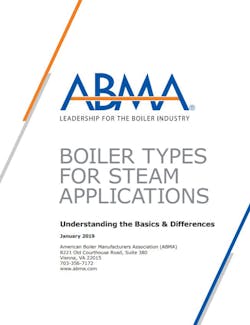HPAC: Let’s start by having you share your boiler industry background with our readers.
I received a Mechanical Engineering degree from the Milwaukee School of Engineering in 1973 and began my boiler industry career at Cleaver Brooks as an R&D engineer. In my 27 years at Cleaver Brooks, I held various technical positions and eventually became the Director of Engineering for my last 13 years. My departure came about due to a great opportunity at Webster Engineering (a burner manufacturer) where I served as Director of Engineering for 11 years until I retired and began consulting.
In my six years of consulting, I have done a wide variety of jobs, from burner development to expert witness to writing articles for the boiler industry. What makes consulting work great for me is that I can have some control over the quantity and type of work that I do. This makes my job very enjoyable and is the reason I continue to work.
HPAC: Please share a specific accomplishment that you are most proud of during your career in the industry.
Product development has always been the most enjoyable part of my job, and there are several new products that I am very proud of. But these are not what really stands out for me.
There are two accomplishments that really stand out to me. The first is my work with the southern California air quality districts in the 1980’s and 1990’s. They had just started to work outside the auto industry and were looking to control emissions from other sources like boilers. In those early days, they worked closely with anyone that would help them understand what could be done to reduce emissions. Boiler manufacturers had done some R&D work on this, but not enough to offer guarantees in NOx emissions. I happened to be in the right place at the right time and was given the opportunity to work with the air quality districts to develop products and regulations to reduce emissions.
Initially, we simply offered Flue Gas Recirculation (FGR) systems that provided a certain percentage recirculation, which we knew would reduce NOx. This was basically the same thing automobiles were doing at that time, and that became the initial regulation, so all boilers had to be built with 20% FGR. After gaining more experience, we felt confident that we could guarantee a NOx emission level of under 30 ppm, and that became the new regulation. In the coming years, 30 ppm NOx became the primary emission requirement in most areas, and it remains as the most common emission standard. The great part of this experience is how well we worked together to reach a goal of helping them clean up their air.
HPAC: Let’s transition to today’s boiler and burner technology. What do you feel are the most impactful recent technology advances in boilers and burners?
The primary drivers to the boiler industry are emissions, efficiency and cost. In my 40+ years in this business, these are always the drivers to what we do. In this case, I believe that it is the outside influence of improved natural gas availability that has and is changing our industry.
Most boilers today are natural gas fired, and because natural gas is a very clean fuel, it allows the boilers to be smaller with the same or better performance. We certainly see this change in the hot water business and making its way into the steam business. Natural gas also provides very low emissions and can easily obtain very low NOx emissions often under 10 ppm NOx.
Controls continue to advance, improving the operation which in turn improves the efficiency. Control integration, making the boiler work with the process, is still a developing area. This is common in newer installations where fuel costs are high, but not as common in smaller or older installations.
Control integration is a means of improving the operations, including fuel use, but it adds cost and complexity. The future growth will be found in simplifying these systems and making them more cost effective to have broader use.
HPAC: How has the evolution in boiler technology impacted the safe operation of the boiler system?
There has been an on-going effort for over 100 years to improve boiler safety. This is being driven by the various codes and regulations that govern this industry. The ASME has been the leader of this effort with the development of codes of construction and safety devices. Other groups like the National Board, Underwriters Laboratory and the National Fire Protection Association have also been heavily involved. These groups continue to look at ways to improve safety through products, installation practices, inspections and training.
Manufacturers also play a big role in improving boiler safety. There has been a constant improvement of the safety control products to provide better safety. Sometimes this comes from simple strategies like providing a warmup cycle within the safety control to prevent thermal shock. Other times it is a control that monitors blow downs to insure they are done as required. All of these have helped improve boiler safety.
Today’s biggest safety issue is the loss of trained technical people to properly operate and maintain boilers. This is not unique to the boiler industry, but it certainly makes this a problem, and the shortage of technical people seems to be getting worse. There are many individuals and groups in our industry that are actively working to change this and attract more people. These positions pay very well, often making well over $100,000 per year, so it is surprising that we have such difficulty finding people to fill them.
HPAC: The boiler industry has made great strides in reducing emissions. What has been the impact of these advances and how much further do you think it can still go?
When we talk about emissions, we could be covering many different areas. When I started in this industry the major concern was acid rain which was killing forests and lakes. Today that issue seems to be resolved, but there are still some acids being released to the environment that may become a future issue.
Smog is the most pressing health issue today, and NOx emissions from boilers is one of the drivers to smog. The NOx emissions from boilers has been dramatically reduced simply because of the change to natural gas (going from an average of 250 ppm on oil to 80 ppm NOx on gas). Gas NOx emissions are also easy to reduce and are typically as low as 5 or 7 ppm in some critical smog areas. We can reduce these to lower levels, but the benefit is questionable.
The CO2 emissions are not currently regulated but are certainly a concern. Again, there have been major improvements simply due to the change from firing oil to firing natural gas, which has less carbon and emits less CO2 emissions. There are currently no boiler technologies to change the basic CO2 emission rate from combustion of natural gas, and it is doubtful that any will be developed. That doesn’t mean that we can’t do anything. It only means we need to look at different approaches.
HPAC: What would you tell an end-user looking to upgrade or replace their boiler system?
I would suggest a couple of action steps. First, get familiar with boilers and boiler systems. I am not suggesting a detailed or technical level of knowledge, but simply an understanding of the different types of products and systems that you might use. This will allow you to ask reasonable questions and evaluate different approaches. Remember that most salespeople will recommend the best product from their offering, but not necessarily other products that they don’t offer.
The next step is to find someone knowledgeable to help evaluate your application. The ABMA Online Buyers Guide is a great option to begin your search. There are many sources for this information, including consulting engineers and manufacturers’ representatives, although you need to verify that they have the experience. You often hear claims of savings up to 10% or 20%, but the reality is that in your application it could also be 0%.
The product offering available today provides a wide variety of different approaches that should be reviewed to make sure you get the best product for your application.
HPAC: What attracted you to join the ABMA team in 2017? How has your role evolved?
I have been involved in the ABMA for many years and active in the technical group for over 20 years. I found this group to be very helpful to me for the same reason that it is helpful to other people, and that is the sharing of ideas and problems with your peers as well as dealing with key issues of the day. We are all faced with similar problems like finding technical talent, evaluating new software tools, working with different listing agencies and so on. This was a great way to discuss these problems with other people.
Our industry is unique in many different ways. One of them is that we are very competitive in the marketplace, but actually helpful to each other in the industry. Some of this is because we all see competitive threats from outside our industry, so working together through ABMA is a natural way of dealing with this. I also think that this is a small industry and there is frequent exchange of people moving from company to company, and that generates a more positive relationship with people from different companies. I was with a company that had a major fire in 2010, and several of our competitors helped us get back on our feet with things as simple as boxes of small, hard-to-find parts.
My role here began with answering some basic technical questions to writing articles for ABMA that help to strengthen our industry. To make sure we have consensus, these articles have a wide review cycle, and they have been very helpful to capture the industry perspective. I feel privileged to be able to represent the industry with these articles and be able to help the industry that has been a major part of my life.
HPAC: Please share details on your role representing ABMA on the National Board Inspection Code and ASME CSD-1 committees. What are some recent code changes that affect the boiler room?
These are interesting groups. The individuals on these committees have a very diverse background and experience, which sometimes brings about interesting discussions. Most of the people on these committees are from inspection agencies, including the state inspectors, insurance companies (that often do inspections) and consulting firms related to this. There are also manufacturers, listing agencies and other related groups.
The groups spend a lot of the time answering technical questions (anyone can ask questions of either group) and modifying the standards for clarification or applications of new technology or changing products.
Some of the issues that are in review are carbon monoxide (to reduce deaths from CO poisoning), Variable Frequency Drives (VFD) on the combustion fan motor (controlling air flow), stack dampers, eliminating size restrictions on modular boilers and new standards for digester gas. Some of these will probably be tabled and some may result in new regulations.
HPAC: You recently authored two ABMA publications on boiler installation and understanding the features of various boiler types. These seem to be a must read for any boiler end-user. What is featured in each publication and why were they so important to write?
The Boiler Installation Guide covers common mistakes in boiler installations. I have had to deal with these same issues year after year, and they are always hard because someone must “prove” that there is a problem and that someone has to pay to fix it. My goal with this article is to make it easy to see what is or is not acceptable so that these problems can be addressed quickly without long fights and even worse, lawsuits. Some of these problems result in equipment damage and serious injuries before they get fixed, and that should not happen.
In addition to the installation guide, I was also interviewed alongside Jim Kolbus, product manager at Clark-Reliance, on Episode #3 of Inside the Boiler Room: Properly Installing A Boiler Is Not As Easy As 1-2-3. This podcast can be downloaded on any major podcast platform.
The article, Boiler Types for Steam Applications, was really an opportunity to provide a more complete review of the advantages and disadvantages of each boiler type. Every company is eager to discuss the advantage of their boilers, but usually not eager to talk about their disadvantages.
As a customer, it is frustrating to find the best boiler for your application if you don’t have a clear understanding of both the advantages and disadvantages. When we talk about the disadvantages, they are not a reflection of issues like quality or reliability, but rather tradeoffs between things like steady state efficiency and dynamic efficiency or the ability to quickly get up to operating steam pressure. The need for very high pressures or superheat are also limiting factors in the boiler selection. A better understanding of these attributes should provide customers a better understanding of the equipment that may be best for their application. This is a common practice today, like putting product reviews in your catalog, so customers can see what others liked and didn’t like about the product.
ABMA also featured this article on Episode #9 of Inside the Boiler Room: The Right Boiler for the Application – Understanding Boiler Types for Steam Applications.
HPAC: What do you see for the future of boiler technology?
I do envision more focus on boilers better suited to different applications. For example, historically we would maintain a hot backup boiler in case of a boiler problem. Most boilers require several hours to warm up without damaging them, and a loss of steam for several hours would be unacceptable. It costs a lot of money, fuel and manpower to maintain a hot standby boiler. An alternative is to use a boiler that can come up to steam pressure in a few minutes from a cold start. These are available in both Firetube and Watertube designs but have not been used simply because of how we have done things for the last 100 years. This is changing.
In a different area, I would expect that we will continue to improve our control system integration, so that we operate the “System” in the most productive way. For example, most steam systems operate at about 80% efficiency, which means that 20% of the energy is lost. This is low temperature heat which has limited uses. I believe that we can find ways to use this energy to improve our overall efficiency, but only if we can effectively operate these systems. If we improved operating efficiencies by 10%, it would have a major impact on operating costs and overall emissions.













